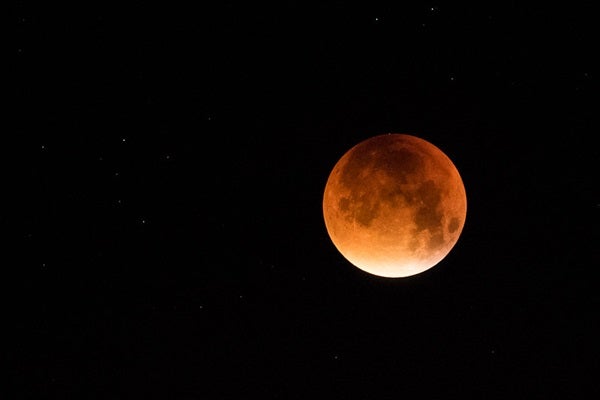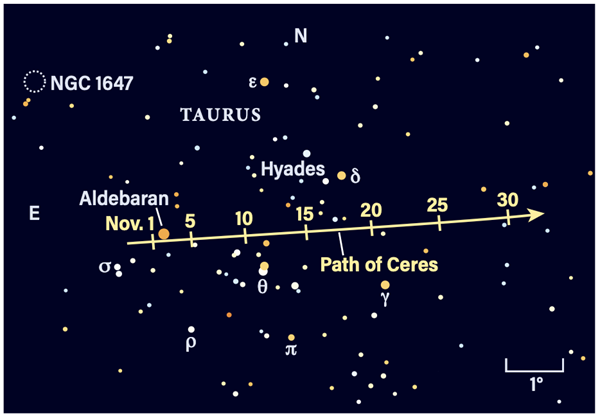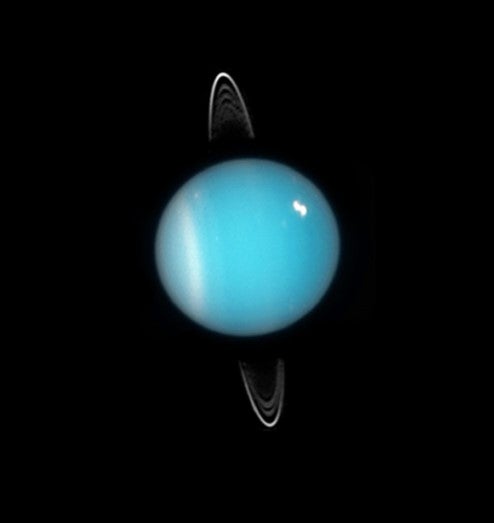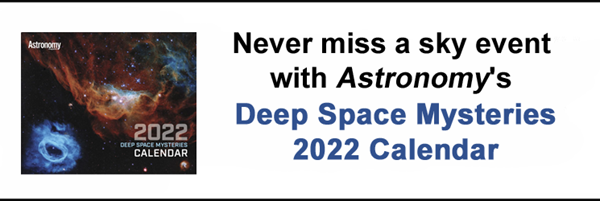Friday, November 12
The Leonid meteor shower is still several days from its peak on the 17th, but that date unfortunately coincides with a nearly Full Moon. That means the next few days are instead your best bet for spotting any meteors associated with this weak shower, which is only expected to produce about 10 per hour above the sporadic background rate, even at its peak.
The Leonids’ radiant is located near 3rd-magnitude Adhafera in Leo the Lion. This region rises around local midnight and is highest closer to sunrise, making the few hours before dawn the best time to scan the skies for any stray streaks of light.
If you’re up late tonight waiting for Leo to peek above the horizon, take some time to enjoy some of the many autumn constellations now gracing the evening sky. Orion, Taurus, and Gemini are on full display before midnight, as are Auriga, Perseus, Andromeda, and Pisces. Several of these constellations have famous asterisms, or unofficial star patterns, tucked within them. In addition to Orion’s Belt, see if you can find Cetus’ head, the W of Cassiopeia, the Circlet of Pisces, and even the Summer Triangle, now sinking in the West. Its descent is mirrored in the east by the rising Winter Hexagon, drawn from the stars Rigel, Sirius, Procyon, Castor, Pollux, Capella, and Aldebaran.
Sunrise: 6:42 A.M.
Sunset: 4:46 P.M.
Moonrise: 2:02 P.M.
Moonset: —
Moon Phase: Waxing gibbous (63%)
*Times for sunrise, sunset, moonrise, and moonset are given in local time from 40° N 90° W. The Moon’s illumination is given at 12 P.M. local time from the same location.
Saturday, November 13
The Moon passes 4° south of Neptune at 2 P.M. EST. You can catch the pair this evening after sunset as they hang in the southeast, sharing the eastern portion of Aquarius.
Now some 4.8° apart, Neptune sits north-northwest of our satellite, which is quickly approaching Full. Through binoculars or a telescope, Neptune’s blue-gray, 2″-wide disk is visible, glowing at magnitude 7.7. You can find it 3° east of 4th-magnitude Phi (φ) Aquarii; if you keep watching over the course of the month, you’ll see the distance between the planet and star slightly shrink as Neptune approaches its stationary point, reaching it December 1st.
Some 28.5° east of the Moon is bright Jupiter, a blazing beacon in the evening sky at magnitude –2.4. For observers in the eastern and midwestern U.S., catching Jupiter shortly after sunset will show only three moons: Ganymede to the east and Europa, then Callisto, to the west. But wait a while, and Io will appear off the planet’s eastern limb, having traveled behind Jupiter’s disk and through its dark shadow to reappear at 7:22 P.M. EST.
Saturn, a much fainter magnitude 0.6, sits nearly 16° farther east of Jupiter.
Sunrise: 6:43 A.M.
Sunset: 4:45 P.M.
Moonrise: 2:28 P.M.
Moonset: 12:53 A.M.
Moon Phase: Waxing gibbous (72%)
Sunday, November 14
Dwarf planet 1 Ceres, the largest body in the main belt, is currently trekking across the loose Hyades open cluster, sprinkled across the narrow nose of Taurus the Bull. Visible in the east by midevening, look first for Taurus’ bright red eye, Aldebaran, about 16° high by 9 P.M. local time.
Just slightly west (to the upper right) of this star as Taurus rises on his side are the Hyades, which sit some 150 light-years away and contain some 400 times the mass of the Sun. This young cluster hosts 10 stars of 4th magnitude or brighter — easily visible with the naked eye.
Turn binoculars or a small scope on the region, and you should easily pick up Ceres’ magnitude 7.7 glow. Tonight, it’s just over 2° west of Aldebaran and nearly 1.5° southeast of magnitude 3.8 Delta (δ) Tauri. It’s in a small region relatively devoid of stars immediately nearby, moving slowly west-northwest. Come back over the next several days (until the Moon grows too bright on the 18th) to watch for the single spot that moves against the glittering background.
Sunrise: 6:44 A.M.
Sunset: 4:44 P.M.
Moonrise: 2:51 P.M.
Moonset: 1:57 A.M.
Moon Phase: Waxing gibbous (81%)
Monday, November 15
Today we celebrate Frederick William Herschel’s 283rd birthday. The accomplished astronomer made many discoveries during his career, the most famous of which is the planet Uranus.
Cap off Herschel’s big day by enjoying an evening view of the ice giant. Uranus reached opposition earlier this month, so it’s up all night. The best time to look for it is around local midnight when it’s highest in the sky, floating in the constellation Aries the Ram. Look south to find Aries’ brightest star, Hamal, and then locate Menkar, Cetus’ alpha star, about 23° to its southeast. Uranus lies roughly halfway between these stars, about 1.5° west-southwest of 6th-magnitude Omicron (ο) Arietis.
Shining at magnitude 5.7, the distant planet is visible with the naked eye under dark-sky conditions. However, depending on your location and with the waxing Moon nearby in Pisces, you’ll likely need binoculars or a small scope to spot its 4″-wide, blue-green disk. The distant ice giant is currently some 1.75 billion miles from Earth.
Sunrise: 6:45 A.M.
Sunset: 4:43 P.M.
Moonrise: 3:14 P.M.
Moonset: 2:59 A.M.
Moon Phase: Waxing gibbous (88%)
Tuesday, November 16
Have you ever seen a demon star? It lurks in Perseus the Hero, rising in the northeast by sunset.
The star in question is Algol, also cataloged as Beta (β) Persei. This bright star is in an eclipsing binary system, meaning its companion passes between it and Earth every orbit, dimming the light we see. In Algol’s case, this occurs every 2.867 days, making the star dip from magnitude 2.1 to 3.4 — that’s a change of 30 percent, enough to notice with the naked eye.
You’ll find the so-called Demon Star, which depicts the severed head of the gorgon Medusa in the constellation’s figure drawing, about 18.5° northwest of the Pleiades in Taurus. Algol is located 93 light-years away and consists of a star some 3.5 times the width of our Sun that is eclipsed by a smaller star about 2.9 times the diameter of the Sun. (In fact, there is at least one more component of this system, which orbits the inner pair every 1.86 years.)
So, step outside tonight and take note of Algol’s brightness compared to the stars around it. Then come back each night for the next few days and observe how it has changed. When uneclipsed, Algol is as bright as nearby Mirfak (Alpha [α] Persei). But during an eclipse, it is clearly fainter.
Sunrise: 6:47 A.M.
Sunset: 4:42 P.M.
Moonrise: 3:37 P.M.
Moonset: 4:00 A.M.
Moon Phase: Waxing gibbous (94%)
Wednesday, November 17
The Leonid meteor shower peaks today, but the bright Moon will make spotting shower meteors nearly impossible. If you missed your chance to search out shooting stars earlier this week, wait a few days until the Moon begins waning, then try again during the early morning predawn hours, when Leo is highest in the sky. The shower lasts until November 30th — but remember that it’s weak and not likely to produce a large number of meteors above the sporadic background limit. Plus, the waning Moon will still grace the early-morning skies, adding some unwanted light.
Speaking of our satellite, the Moon passes 1.5° south of Uranus at 9 P.M. EST tonight. The pair shines in Aries, which is bordered by the constellations Cetus, Pisces, Triangulum, Perseus. Taurus, and Eridanus. Although the Moon will be bright, you can still catch a glimpse of Uranus through binoculars or a telescope. It’s currently 11.3° northwest of a 7th-magnitude field star, HIP 12349.
While you’re in the area, you might also zoom in on clusters such as like the Pleiades and the Perseus Double Cluster, which will be visible — if somewhat diminished — by the bright moonlight.
Sunrise: 6:48 A.M.
Sunset: 4:42 P.M.
Moonrise: 4:00 P.M.
Moonset: 5:01 A.M.
Moon Phase: Waxing gibbous (97%)
Thursday, November 18
Saturn’s two-faced moon Iapetus reaches inferior conjunction today, appearing closer to the ringed planet than usual. Turn a telescope toward Capricornus after dark to see the 11th-magnitude moon roughly 34″ south of Saturn. Its darker face is currently turned toward us, but that’s changing — its lighter side will rotate into view for the second half of the month, so come back to check in on the moon in a week or two to see how its brightness has changed.
More easily visible is Saturn’s largest moon, Titan, sitting 2.8′ due west of Saturn and glowing at magnitude 8.7. Over the next few days, its orbit will carry it northeast (counterclockwise), until it sits due north of the planet on the 22nd.
Don’t forget — how could you? — to also stop and admire Saturn’s rings, which span about 38″ (compared to the disk, which stretches only 17″ across).
Sunrise: 6:49 A.M.
Sunset: 4:41 P.M.
Moonrise: 4:26 P.M.
Moonset: 6:01 A.M.
Moon Phase: Waxing gibbous (99.6%)
Friday, November 19
With the Moon well over 99 percent illuminated, the stage is set for a near-total lunar eclipse visible across the entire U.S., including Alaska and Hawaii. It’s worth staying up late on the 18th or getting up early on the 19th (depending on your time zone) to view at least some of it. As a bonus, this is the longest partial lunar eclipse that will occur this century, so it should be easy to catch!
Dive into our November magazine feature by former Astronomy senior editor Michael Bakich for details on how to catch this week’s eclipse.
The Moon first slips into Earth’s outer shadow (penumbra) around 1 A.M. EST (10 P.M. PST on the 18th, for those on the West Coast). An hour later, the Moon enters the darker inner shadow (umbra) and the partial eclipse begins. This is when the Moon will start growing noticeably dimmer and take on an orange or reddish hue — the exact color varies, depending on the conditions in Earth’s atmosphere during any given eclipse.
The eclipse will take several hours, reaching maximum around 4 A.M. EST (1 A.M. PST), when Earth’s umbra will cover roughly 98 percent of our satellite. Only a small portion of the Moon will remain outside the umbra. This is just after the time Full Moon officially occurs, which is 3:57 A.M. EST. (November’s Full Moon is also called the Beaver Moon.)
The partial phase of the eclipse ends just before 5:50 A.M. EST, with the penumbral phase ending around 7 A.M. EST.
Frequent astronomy livestreamer David Brewer plans to capture the eclipse from Denver, Colorado. You can catch the stream below.
If you recall, last November featured a lunar eclipse as well, but this was a penumbral eclipse, during which the Moon only passed through the outer region of Earth’s shadow for a much less dramatic effect.
Sunrise: 6:50 A.M.
Sunset: 4:40 P.M.
Moonrise: 4:56 P.M.
Moonset: 7:03 A.M.
Moon Phase: Full













